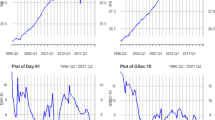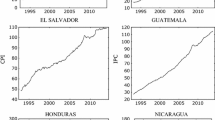Abstract
This article examines the long-run money demand function for 11 OECD countries from 1983Q1 to 2006Q4 using panel data. The distinction between common factors and idiosyncratic components using principal component analysis allows for the detection of cross-member cointegration and the determination as to whether national or international sources are responsible for the non-stationarity of money and its determinants. Indeed, the finding that the common factors are I(1) while the idiosyncratic components are I(0) indicates that cross-member cointegration may exist and non-stationarity in the variables is primarily driven by common international trends. Furthermore, it is found that the impact of income on money demand is positive, whereas it is negative for the interest rate, exchange rate and stock prices. Except for the income elasticity of money demand, all estimated long-run coefficients are larger for the common factors of the variables than for the variables themselves. This article provides evidence that the exchange rate is an important determinant of money demand, whereas the results for the stock prices are ambiguous. Finally, the results of a panel-based error-correction model suggest that several domestic money stocks converge to a common international equilibrium relationship between the common factors.
Similar content being viewed by others
References
Arellano M, Bond S (1991) Some tests of specification for panel data: Monte Carlo evidence and an application to employment equations. Rev Econ Stud 58(2): 277–297
Arnold IJ, Roelands S (2010) The demand for euros. J Macroecon 32(2): 674–684. doi:10.1016/j.jmacro.2010.01.001
Bai J, Ng S (2002) Determining the number of factors in approximate factor models. Econometrica 70(1): 191–221
Bai J, Ng S (2004) A PANIC attack on unit roots and cointegration. Econometrica 72: 1127–1177
Banerjee A, Marcellino M, Osbat C (2004) Some cautions on the use of panel methods for integrated series of macroeconomic data. Econom J 7(2): 322–340
Boone L, Noord P (2008) Wealth effects on money demand in the euro area. Empir Econ 34(3): 525–536
Breitung J, Pesaran MH (2008) Unit roots and cointegration in panels. In: Matyas L, Sevestre P (eds) The econometrics of panel data: advanced studies in theoretical and applied econometrics, vol 46. Springer, Berlin., pp 279–322
Bruggeman A, Donati P, Warne A (2003) Is the demand for euro area M3 stable? ECB Working Paper No. 255
Campbell JY, Perron P (1991) Pitfalls and opportunities: what macroeconomists should know about unit roots. In: Blanchard OJ, Fisher S (eds) NBER macroeconomics annual, vol 6. MIT Press, Cambridge, pp 141–220
Choi I (2001) Unit root tests for panel data. J Int Money Finance 20(2): 249–272
Choudhry T (1996) Real stock prices and the long-run money demand function: evidence from Canada and the USA. J Int Money Finance 15(1): 1–17
de Bondt GJ (2009) Euro area money demand - Empirical evidence on the role of equity and labour markets. ECB Working Paper No. 1086
de Santis RA, Favero CA, Roffia B (2008) Euro area money demand and international portfolio allocation—a contribution to assessing risks to price stability. ECB Working Paper No. 926
Dickey DA, Fuller WA (1979) Distribution of the estimators for autoregressive time series with a unit root. J Am Stat Assoc 74(366): 427–431
Dreger C, Wolters J (2010) Investigating M3 money demand in the euro area. J Int Money Finance 29(1): 111–122. doi:10.1016/j.jimonfin.2009.02.002
Dreger C, Reimers H, Roffia B (2007) Long-run money demand in the new EU member states with exchange rate effects. East Eur Econ 45(2): 75–94
Elbadawi IA, Schmidt-Hebbel K (2007) The demand for money around the end of civil wars. The World Bank. http://siteresources.worldbank.org. Accessed 10 May 2010
Ericsson NR (1998) Empirical modeling of money demand. Empir Econ 23(3): 295–315
Fidrmuc J (2009) Money demand and disinflation in selected CEECs during the accession to the EU. Appl Econ 41(10): 1259–1267
Friedman M (1970) A theoretical framework for monetary analysis. J Political Economy 78: 193–238
Friedman M (1988) Money and the stock market. J Political Economy 96: 221–245
Garcia-Hiernaux A, Cerno L (2006) Empirical evidence for a money demand function: a panel data analysis of 27 countries in 1988–1998. Appl Econom Int Dev 6(1):51–58
Gengenbach C, Palm FC, Urbain JP (2006) Cointegration testing in panels with common factors. Oxf Bull Econ Stat 68(S1): 683–719
Gengenbach C, Urbain J, Westerlund J (2009) Error correction testing in panels with global stochastic trends. METEOR
Hamori S (2008) Empirical analysis of the money demand function in Sub-Saharan Africa. Econ Bull 15(4): 1–15
Hamori S, Hamori N (2008) Demand for money in the Euro area. Econ Syst 32(3): 274–284
Harb N (2004) Money demand function: a heterogeneous panel application. Appl Econ Lett 11(9): 551–555
Johansen S (1995) Likelihood-based inference in cointegrated vector autoregressive models. Oxford University Press, Oxford
Johansen S, Juselius K (1990) Maximum likelihood estimation and inference on cointegration—with applications to the demand for money. Oxf Bull Econ Stat 52(2): 169–210
Juselius K (2006) The cointegrated VAR model: methodology and applications. Oxford University Press, Oxford
Knell M, Stix H (2005) The income elasticity of money demand: a meta-analysis of empirical results. J Econ Surv 19(3): 513–533
Knell M, Stix H (2006) Three decades of money demand studies: differences and similarities. Appl Econ 38(7): 805–818
Kumar S (2010) Panel data estimates of the demand for money in the pacific island countries. EERI Research Paper Series No. 2010-12
Kumar S, Chowdhury M, Rao BB (2010) Demand for money in the selected OECD countries: a time series panel data approach and structural breaks. MPRA Paper No. 22204
Laidler DE (1993) The demand for money: theories, evidence and problems, 4th edn. Harper Collins College Publishers, New York
Levin A, Lin C, Chu CJ (2002) Unit root tests in panel data: asymptotic and finite-sample properties. J Econom 108(1): 1–24
Ljung GM, Box GEP (1978) On a measure of lack of fit in time series models. Biometrika 65(2): 297–303
MacKinnon JG, Haug AA, Michelis L (1999) Numerical distribution functions of likelihood ratio tests for cointegration. J Appl Econom 14(5): 563–577
Maddala GS, Wu S (1999) A comparative study of unit root tests with panel data and a new simple test. Oxf Bull Econ Stat 61: 631–652
Mark NC, Sul D (2003) Cointegration vector estimation by panel DOLS and long-run money demand. Oxf Bull Econ Stat 65(5): 655–680
Narayan P, Narayan S, Mishra V (2009) Estimating money demand functions for South Asian countries. Empir Econ 36(3): 685–696. doi:10.1007/s00181-008-0219-9
Nautz D, Rondorf U (2010) The (in)stability of money demand in the Euro Area: lessons from a cross-country analysis. SFB 649 Discussion Papers No. 2010-023
Newey WK, West KD (1987) A simple, positive semi-definite, heteroskedasticity and autocorrelation consistent covariance matrix. Econometrica 55(3): 703–708
Pedroni P (1999) Critical values for cointegration tests in heterogeneous panels with multiple regressors. Oxf Bull Econ Stat 61: 653–670
Pedroni P (2000) Fully modified OLS for heterogeneous cointegrated panels. In: Advances in econometrics, vol 15. Emerald (MCB UP), Bingley, pp 93–130
Pedroni P (2001) Purchasing Power Parity tests in cointegrated panels. Rev Econ Stat 83(4): 727–731
Pedroni P (2004) Panel cointegration, asymptotic and finite sample properties of pooled time series tests with an application to the PPP hypothesis. Econom Theory 20: 597–625
Pesaran MH, Shin Y, Smith RP (1999) Pooled mean group estimation of dynamic heterogeneous panels. J Am Stat Assoc 94: 621–634
Phillips PCB, Perron P (1988) Testing for a unit root in time series regression. Biometrika 75(2): 335–346
Poole W (1970) Optimal choice of monetary policy instruments in a simple stochastic macro model. Q J Econ 84(2): 197–216
Rao BB, Kumar S (2009) A panel data approach to the demand for money and the effects of financial reforms in the Asian countries. Econ Model 26(5): 1012–1017. doi:10.1016/j.econmod.2009.03.008
Rao BB, Tamazian A, Singh P (2009) Demand for money in the Asian countries: a systems GMM panel data approach and structural breaks. MPRA Paper No. 15030
Reimers H (1992) Comparisons of tests for multivariate cointegration. Stat Pap 33(1): 335–359
Reinsel GC, Ahn SK (1992) Vector autoregressive models with unit roots and reduced rank structure: estimation, likelihood ratio test, and forecasting. J Time Ser Anal 13(4): 353–375
Setzer R, Greiber C (2007) Money and housing: evidence for the euro area and the US. Deutsche Bundesbank Discussion Paper 12/2007
Setzer R, Wolff GB (2009) Money demand in the euro area: new insights from disaggregated data. MPRA Paper No. 17483
Urbain J, Westerlund J (2006) Spurious regression in nonstationary panels with cross-unit cointegration. METEOR Research Memoranda No. 057
Valadkhani A (2006) What determines the demand for money in the Asian-Pacific countries? An empirical panel investigation. Faculty of Commerce—Economics Working Papers 06-11, Department of Economics, University of Wollongong
Valadkhani A (2008) Long- and short-run determinants of the demand for money in the Asian-Pacific countries: an empirical panel investigation. Ann Econ Finance 9: 77–90
Valadkhani A, Alauddin M (2003) Demand for M2 in developing countries: an empirical panel investigation. School of Economics and Finance Discussion Paper No. 149, Queensland University of Technology
Author information
Authors and Affiliations
Corresponding author
Rights and permissions
About this article
Cite this article
Dobnik, F. Long-run money demand in OECD countries: what role do common factors play?. Empir Econ 45, 89–113 (2013). https://doi.org/10.1007/s00181-012-0600-6
Received:
Accepted:
Published:
Issue Date:
DOI: https://doi.org/10.1007/s00181-012-0600-6




